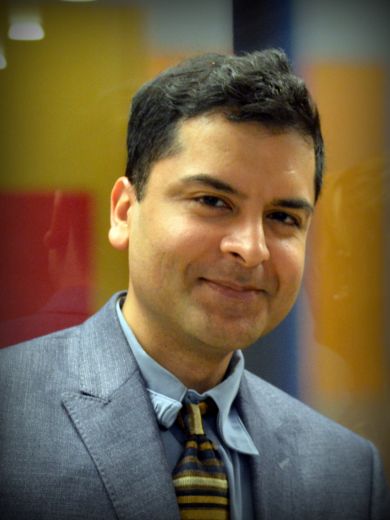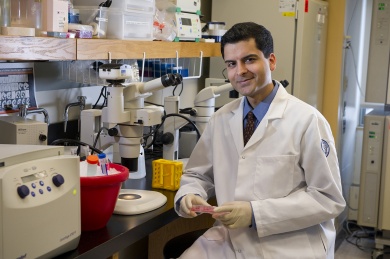Fluorescent tag called Spinach
This feature originally appeared on the new Cornell Research site.
Tools have been the ticket to the human race’s success—each technology created over the millennia has led to leaps in understanding and progress. Samie Jaffrey, Pharmacology at Weill Cornell Medicine, has taken this truth to heart. “We’re invested in creating new tools that can allow us to explore new areas of biology,” says Jaffrey. This approach has already led to exciting scientific insights that may lead to novel therapies for some of our most devastating diseases.
Jaffrey’s group has applied their innovation toward the relatively new and uncharted field of noncoding RNAs. These molecules are generated from what was once called “junk DNA”—the DNA that did not translate into genes and proteins. Seventy percent of all of our DNA produces noncoding RNAs, and scientists are just now discovering how crucial a role they play in genetic expression and disease states. “The cell is filled with these mysterious RNAs,” says Jaffrey. “They’re everywhere, and we don’t know what they’re doing—it’s a whole new aspect of biology that we're only just beginning to uncover.”
Pioneering an Imaging Technology
Jaffrey’s team has taken a giant step in revealing more about this world with a breakthrough imaging technology. “Our core philosophy is if we can see the noncoding RNA, we can understand their function,” says Jaffrey. His team created a synthetic RNA strand designed to bind to a fluorescent dye. When the dye is bound to RNA, it lights up. This tag, which Jaffrey’s teamed named ‘Spinach’ for its green fluorescence, suddenly made it possible to image RNA as it went through its life cycle in living cells. Prior to this innovation, scientists could only image RNA after they treated the cells fixatives, which kills the cells. This process captures a snapshot image of the RNA at the moment the cell died. “But a snapshot isn’t enough,” says Jaffrey. “You need to see things moving in order to really understand what’s happening. Our technology allows us to use the living cell and to see how RNA moves in real time or in response to a signal.”
If We Had Not Seen It, We Could Not Have Identified Potential Therapies
With Spinach, Jaffrey and his team were able to see exactly how these noncoding RNAs behaved throughout the cell. This new insight was fascinating not only from a cell biology standpoint but from a medical one as well. Jaffrey and his team applied this tool to view cells containing what’s known as “toxic RNA”—RNA strands with repeat base sequences throughout the strand. Toxic RNA shows up in the cells of people with certain neurodegenerative diseases, such as ataxia, Lou Gehrig's disease, and myotonic dystrophy. Scientists thought that the toxic RNA formed clumps within the nuclei of these diseased cells, the theory being that these clumps were inherently harmful but without much insight as to why. Jaffrey and his team decided to shed some light, literally, on these mysterious molecules.
“When we labeled this toxic RNA with Spinach, we were able to see that they weren’t forming clumps,” says Jaffrey, “they were piggybacking onto normal structures found in the nucleus—actually integrating themselves and impairing their function.”
With this new insight, Jaffrey’s team was then able to do the first drug screens to identify potential therapies that could disrupt these clumps and return the affected cells to their normal, functional state. These preliminary screens have revealed some promising candidates for eliminating the toxic RNA from a cell. “All of this was possible because we were able to actually see the toxic RNA in real time,” Jaffrey says. “If we hadn’t seen that, we wouldn’t be able to then investigate molecules that could disrupt that activity.”
Next Step, Seeing in the Infrared
Jaffrey’s work in this area has drawn excitement and attention from the scientific community, with the team’s papers appearing in top-tier journals such as Science and Nature Methods. But Jaffrey’s team isn’t spending time basking in the glow of success. They’re already working to improve the technology. “We want to get the sensitivity of the imaging more accurate so that we can watch the individual RNA strands and monitor their trafficking from birth to death,” says Jaffrey. His team is also working to tinker with the tags so that they light up in the infrared light spectrum. The hope is that this new type of tag will allow them to observe RNA in living animals, since infrared light can travel through tissue. Researchers could then observe how tagged RNA behaves in living tissue of animal models of certain disease states.
While drug therapies from this discovery are still years away, Jaffrey’s imaging technology has given researchers a first peek, literally, at how these poorly understood molecules affect the body’s health. The discovery is a satisfying tie-in to Jaffrey’s fascination with inventing new technology. “I’ve always had an interest in not just exploring research questions,” he says, “but creating tools to solve problems. I’m a strong believer that tools are one of the best ways to make new discoveries. It’s an approach that appeals to me.”




